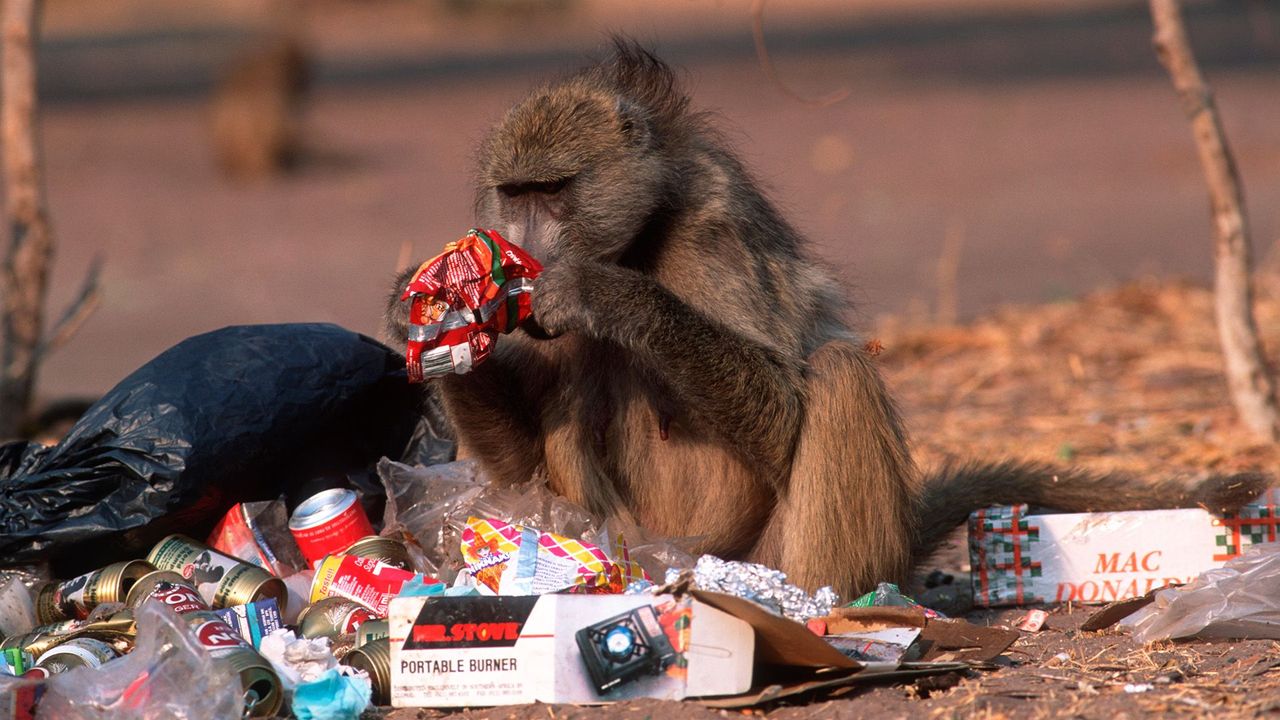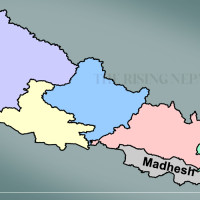- Saturday, 4 May 2024
The scavengers stalking the world's cities
By BBC Future Planet Team

(Credit: Alamy)
From ibis to hyenas, a surprising variety of scavengers have been drawn to urban life. Here's how they're thriving in cities across the globe.
On the road to Cape Point Nature Reserve, on the outskirts of the South African city of Cape Town, each day people must run the gauntlet of a gang with a habit of "car-jacking".
The culprits are notorious – perhaps known as much for the occasional vehicle break-in, as they are for their potently smelly breath. They are, in fact, baboons. And they have taken to life among people with surprising zeal. Further into the city, marauding troops of the primates have learned to raid bins and even invade homes, in the search for an easy meal. The scavengers have become so prolific, that there is now a 24-hour baboon hotline, where residents can report offences, as well as welfare concerns.
Of course, baboons are not the only wildlife that has been drawn to humanity's urban sprawl. Across the planet, the original inhabitants of areas now occupied by cities have been standing their ground and learning to thrive, alongside millions of people. Here are some of the extraordinary transformations that have been unfolding.

Foxes can be surprisingly vocal, and make 40 different sounds (Credit: Getty Images)
Foxes
Each night, as dusk settles over cities throughout Europe, red foxes emerge from their hiding places and begin stalking the streets. Sometimes they saunter confidently along, mingling seamlessly with human pedestrians. Occasionally it's just possible to glimpse the whip of a fluffy tail, as one dives into a bin. These adaptable omnivores will forage for wild foods such as berries and insects, supplementing this with freshly caught pigeons and scraps found in rubbish.
There are at least ten different kinds of "true" fox scattered throughout the planet, from the strange bat-eared fennec fox to the charismatic Tibetan sand fox. They have been living among people for millennia – in 1991, researchers unearthed the ancient bones of an individual in Argentina, which recent research has revealed may have been a pet. Today, foxes are thriving in urban areas, with 18 per square kilometre (45 per square mile) in London alone. They're also found in cities in the US, particularly in the northern and eastern parts of the country.

Coyotes are members of the dog family (Credit: Getty Images)
Coyotes
Coyotes have become ubiquitous in US cities in recent decades. The canines are opportunistic scavengers; they will eat whatever is available, including mice, rabbits, frogs, lizards and food waste extracted from people's bins. A 2022 study analysing the diet of coyotes in New York City found that they consumed large mammals such as deer and raccoons as well as human foods such as chicken, pork and beef. Their flexible diets make them highly adept at urban living. But scientists warn that their consumption of junk food may pose a risk to humans, as urban coyotes tend to carry more parasites and have unhealthier microbiomes – a trait which has been linked to aggressive behaviour.

Sea gulls are highly intelligent, and in the UK some have learned to steal packets of crisps from shops (Credit: Alamy)
Sea Gulls
Many a stroll in a seaside town has been derailed by a passing seagull's brazen food grab. In coastal cities, it can feel like these birds are ruthless opportunists, invading towns in order to pilfer the rich pickings of picnics, barbecues, and even firmly gripped street-food snacks. In fact, it is we who have been invading the birds' habitat. Declining fish stocks and loss of their natural habitat are thought to have contributed to city gulls' search for food elsewhere, including cities and landfills.
"Over time, they'll build a repertoire of quite skilled behaviours which enables them to liberate food either from your bins or from humans directly," Paul Graham of the University of Sussex in the UK tells BBC News. "I think we need to learn how to live with them."
Next time your food is snatched by a voracious gull, perhaps consider whether we snatched their fish first.

Wild boar are the ancestors of domesticated pigs (Credit: Getty Images)
Wild boar
Although reclusive by nature, the lure of suburban life is bringing wild pigs into the lamplight. From the hills of Hong Kong to the beaches of Mediterranean Marbella, where once feral pigs rooted through soil and leaf litter, now they rummage through rubbish. In Berlin, they doze in paddling pools. In Spain, a pair snatched the Colombian pop star Shakira's bag. And, wherever they are, run-ins with local authorities or culling teams are often soon to follow.
In the US, where boar are non-native, they are also considered an invasive pest. With populations counted at around six million and rising, at least 35 states now report wild pig populations. The result is an estimated annual $2.5bn (£2.1bn) in damage to US crops, such as peanuts and corn.
But just because they are invasive, doesn't necessarily mean their impacts are all bad. In fact, new research is exploring the ways in which their rooting noses and pawing hooves might actually have benefits for local ecosystems; off-setting the grip of dominant plants and potentially mimicking the effects of ancient mega-fauna.

Hyenas are often feared, but in some places, they have peacefully coexisted with people for decades (Credit: Alamy)
Hyenas
Hyenas are the infamous villains of the animal kingdom. But these scavengers are not all bad. Hyenas provide significant health and economic benefits to the African cities they stalk, according to a 2021 study by the University of Michigan. Collectively, hyenas remove 207 tonnes (456,000lb) of animal carcass waste annually in Mekelle, northern Ethiopia, preventing an estimated five infections of anthrax and bovine tuberculosis among residents and 140 infections in cattle, sheep and goats annually. In the city of Harar in eastern Ethiopia, the animals even venture inside the city's walls at night, where they feed on scraps and entrails left out by the city's butchers. Small openings in the city's 13th-century walls – known as hyena gates – allow the animals to pass through freely.
Communities on the fringes of Ethiopian cities value hyenas as they "understand the sanitation services they provide," Chinmay Sonawane, a biologist from Stanford University in California, tells BBC Future.

In Africa, elephants are sometimes forced to visit human settlements to get from one wild space to another (Credit: Getty Images)
Elephants
The animals can often be seen snuffling through reeking piles of rubbish on the outskirts of Kotdwar, a city in the Uttarakhand district of northern India. They probe the waste with their noses, occasionally pausing to gulp down any tasty morsels they discover. But these creatures are not rats or feral dogs feasting on the discarded spoils of human habitation – they are among the biggest land animals on the planet, Asian elephants.
Kotdwar – a rapidly growing city estimated to have 45,000 people living there – sits on the fringes of the forest habitats where the elephants are normally found.
As human urban populations have grown close to the forests, it has presented the elephants with some novel and surprising sources of food. One study of elephant dung found in and around the forests of Uttarakhand found tell-tale signs that the animals have been foraging in human rubbish dumps for food.
And it appears that elephants living near Kotdwar have particularly taken to this dumpster-diving lifestyle. Sadly, all samples of their dung from around Kotdwar held plastic packaging, bags, food containers and even disposable cutlery that they had eaten while seeking out leftover food, according to researchers from the Jawaharlal Nehru University in New Delhi.
It is a habit that has also been observed among Asian elephants in Sri Lanka, where garbage dumps provide an easy food source for the animals. One study of elephants feeding on waste at a dump in southern Sri Lanka found the animals were in"better body condition" than those that did not forage from human rubbish. But there have also been reports of elephants dying after eating large amounts of plastic waste at dumps.
There are also concerns that, as human urban populations grow in areas where wild elephants are normally found, the risk of dangerous encounters between our species will increase. Human-elephant conflicts can often have fatal results for both sides.

When vultures scavenge in cities, they help to remove waste (Credit: Alamy)
Vultures
Since ancient times, vultures have been viewed as symbols of bad luck and harbingers of death. But these scavenging birds, which exclusively eat the carcasses of dead animals, play a vital role in preventing pathogens from spreading to humans and wildlife and contaminants from leaching into the environment. Vultures are disappearing at an alarming rate in South Asia and Africa. Widespread poisoning by the veterinary painkiller diclofenac in the 1990s and 2000s led to a 99% decline in the populations of India's three most common vulture species. This has now stopped due to a ban on the use of the drug. In Africa, many vultures are killed because of religious beliefs, with their heads sold as good luck charms or ground up and used in traditional medicines.

Black bears are sometimes attracted to cities by household waste, bird feeders, compost piles and other sources of food (Credit: Alamy)
Bears
In the US, you're more likely to be killed by a bee than a bear, but incidents of bears encroaching on human areas are becoming more common. Or, is it the other way around? Grizzly bears used to inhabit most of the western US, while black bears were common in forested areas throughout the country. Today, 2,000 grizzlies occupy just 6% of their historical range, while 300,000 black bears live in 50% of theirs. They're highly intelligent and inquisitive creatures, and their powerful noses and voracious appetite mean they'll go to great lengths to find food.
Most bear conflicts happen when human food – like rubbish, dog food, or fruit trees – is readily available. Bears have been captured on camera breaking into homes to steal food, earning one 500lb (226kg) bear burglar the moniker "Hank the Tank".
Although bear hunting is still permitted in some states, government wildlife agencies are educating the public on how to peacefully coexist with bears.

In its natural wetland habitat, the Australian white ibis nests in vast colonies of up to 20,000 individuals (Credit: Getty Images)
Ibis
With plump white bodies and long leathery necks and feet, the Australian white ibis is sometimes described as graceful and elegant – at least when it is in its natural wetland habitat. In Australia's cities, it is a different matter. The "bin chicken" or "tip turkey", as the bird is often not-so-affectionately named, can often be found loitering around sewage treatment plants or pecking through rubbish. But though urban communities of this bird tend to be viewed more as pests than national treasures, research suggests that they might provide a vital reservoir of genetic diversity that could help to replenish wild populations elsewhere.

Wasps are important pollinators (Credit: Getty Images)
Wasps
Wasps enjoy a reputation as the perennial picnic party pooper, winging in to gorge on jam sandwiches, fruit salad and other treats. But their sweet tooth may be overplayed; in the wild, they will feed on carrion just as happily as they will on rotting fruit.
In areas where European wasps have made a relatively recent entrance – such as in Australia and New Zealand – scientists have been able to observe their dramatic impact on other scavenging species. A 2020 study, conducted in Australia, showed that wasps quickly arrived to feed on fresh carcasses and aggressively attacked competing blowflies – to the point where the flies were not able to lay eggs. Larger vertebrate scavengers such as dingoes were also attacked.
And there is evidence that wasps are adapting to city life at a genetic level, too. As temperatures rise due to global climate change, one recent study found that hotter urban areas with less vegetation tend to be home to smaller wasps. This may provide an evolutionary advantage because their lighter bodies need to use less energy to stay in the air.




-square-thumb.jpg)




-original-thumb.jpg)






